May 18 - 24, 2014: Issue 163
Ken Beashel
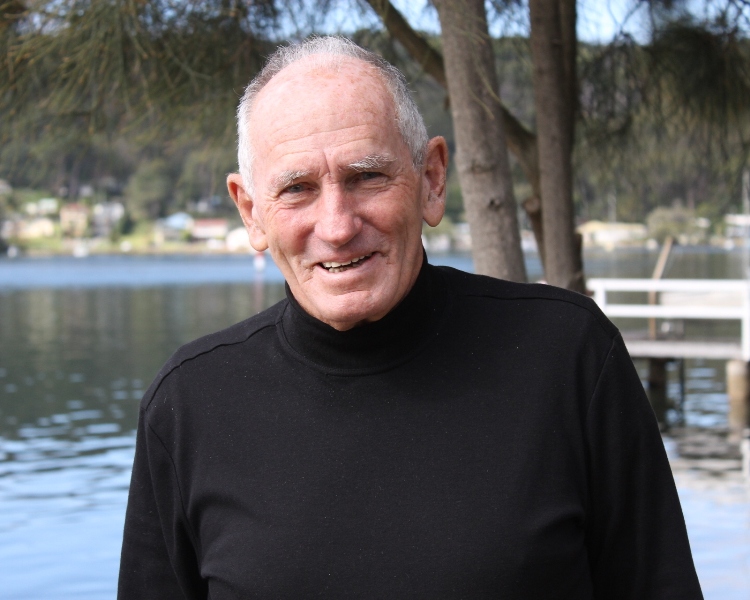
Ken Beashel is a third generation skiff sailor who twice won the “world” J.J.Giltinan championship in 18ft skiffs and an Australian 16ft skiff championship. A skilled shipwright, Mr Beashel has designed and built more more kinds of boats in a number higher then many could count, including those he is still passionate about 16s and 18s. Always innovative, he learnt his craft through observation of all manner of boats on Sydney Harbour when younger and in the premier boat builder's yards of Sydney.
Ken went racing international Soling and 5.5 metre keelboats, worked and sailed on Sir Frank Packer’s 1967 America’s Cup challenger Gretel and headed the maintenance team in Australia II’s 1983 America’s Cup win....and that's just for openers:
Richard and Alf ; what are your earliest memories of these relatives?
From what I can gather, one of my earliest memories of grandfather is he lived at Clovelly. He originally came from The Rocks – Dawes Point and lived there until 1929. I asked one of my aunties, who lived at Seaforth until she was 98, what made you go to Clovelly from Dawes Point; she said ‘we used to go out in his 18 footer – The Golding of a Sunday to go to a beach and the only beach we’d go to was Seven Bob Beach in Double Bay or Nelson Park also at Manly – it was just great because we couldn’t swim at Dawes Point – the water was so dirty, the harbour was so dirty in those days.
Grandfather bought a motorcycle and a sidecar and used to work in the city as a cleaner for the City of Sydney as well as being mixed up in sailing. She said this was 1929 – ‘we had to leave and we said to dad (grandpa) that we wanted to go to somewhere where there’s a beach – they had to pull the house down to build the southern pylon of the Harbour Bridge.’
I thought ‘what a place to live!’ you couldn’t have wished for a better place. At any rate, they went to Clovelly.
His father and brother came out from Ireland in 1878 on a ship (Tyburnia) – they were Joseph and Richard. They went to New Zealand for two years to pay for their passage and then came to Australia – one went south to Moruya and he became a boatman down at Moruya – that brother’s children have big properties down there. Then Ratho (Richard) Beashel, which was grandfather’s dad, settled in at The Rocks.
Grandfather had three 16-footers; the Lark, Linnet and the Thrush, all Irish birds, and the one 18-footer called ‘The Golding’.
Alf and Richard, one of the brothers, had 16-footers, Richard had the Linnet and dad had the Thrush in 1923 – he was born in 1904 so he was pretty young when he had his first success in that boat. I just can’t work out how he got the money as it was built by a famous boat builder called Edgar Dearing at Drummoyne and it was 70 pounds, which was a lot of money back then – but then I’ve been reading old programmes and they were getting 14 pounds in prize money! So I think grandfather did pretty good out of the 18-footers, and I think dad must have done alright too. That’s how they did it I think.
In 1935 dad built his first 18-footer down at The Rocks – the Alruth, named after himself –Alfred and my mother’s name ‘Ruth’.
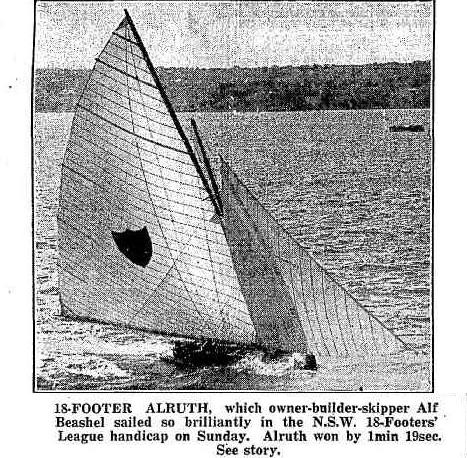
No title. (1938, October 6). Referee (Sydney, NSW : 1886 - 1939), p. 15. Retrieved from http://nla.gov.au/nla.news-article127508034
I do remember a bit about his second 18-footer being built the Alruth II – down at Woolloomooloo Bay. I remember I would go with Sid Press, the boat shed proprietor's son in his 6ft dinghy and pinch the 44 gallon drums from the fuel depot down there and tow them over to the USA warships for the sailors to use them to go out on the town after swimming with their clothes on the drums and so they did not have to use the gangway. They would repay us on Sunday morning with Gob Hat cigarettes and chewing gum which I then sold to other school kids and did very well out of it.
Where were you going to school?
Those days it would have been St. Anthony’s Clovelly or Maris brothers, Randwick.
What was school like for you?
No bloody good – I wasn’t one for school. I liked arithmetic at school and I like geography but that was it. When they got into that Shakespeare they lost me. Then I stuffed up – I started wagging school too early. Mum passed away when I was 12 and I started wagging school then. You had to be on the button with algebra - unless you learnt it right from scratch you were behind and I got myself behind running around Sydney Cove looking at boats.
When did you start racing?
My first win was when I was 10 in an 18 foot boat called the Alruth. Then I won again that same season in a boat called No Mistake.
I sailed my first race as a skipper when I was 15, which was a novice skipper’s race in what they called the Port Jackson 16 foot Skiff Club, which was the original club, and I won that and built my first boat and raced that and won in the 16’s. She was called the Thrush, after the name of dad’s boat – this was a planked boat I designed and built in the backyard and raced. That was the only boat I owned for two years. I then sold it and had a boat every year – because I wanted to learn more about design and had to sell the boat to pay for the sails and whatnot.
What were the differences between the first boat you built and one five years on?
The first one was what we call a plank boat, my next one, Intrigue, was a molded boat; the first one, I don’t know what it weighed but I did weigh a similar boat once when we built the first molded boat in Sydney and it weighed 154 pounds; the boat which we weighed, a plank boat, weighed was 274 pounds – so that was the big difference, half the weight – and not only lighter, stiffer and stronger and faster.
We sailed Intrigue against the famous Billo Hayward in the Port Jackson Championships and he beat us by three seconds and I’m sure it’s only the fact that I had a faster boat that I kept up with him – I learnt a lot from him – he was one of these great sailors that no one could beat. Billo Hayward was the first guy to win a 16 and an 18 foot title, I was the second and Trevor Barnabas was the third and there hasn’t been any others since then.
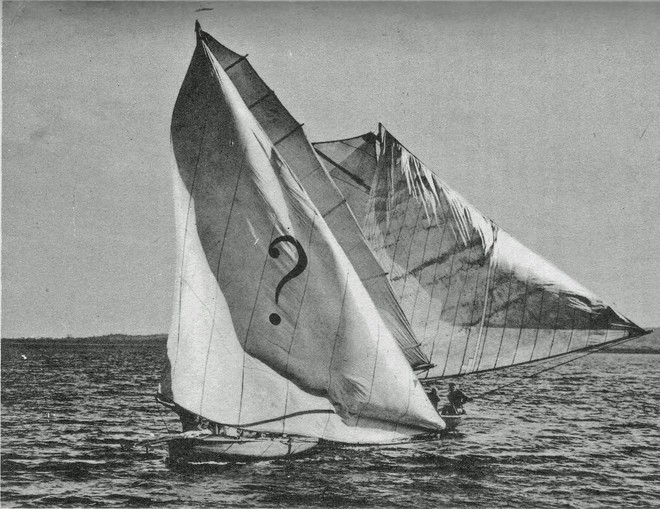
Intrigue on the Harbour - image courtesy Australian National Maritime Museum
What did you learn about sailing from your dad?
I learnt from dad that it is important to sail the boat well, to windward. Most of what I learnt from dad I learned from observation – the only thing he really told me was ‘when you tack your boat, when you feel the boat’s fast, keep a mark on the shore and an eye on whether you’re high or low and whether you’re lifting and learn a thing from there. Just try to sail the boat so it makes you feel good.’
What I learnt from him is probably more through memory of what he used to do as the years went on; that’s what I learnt, and I’m still learning. I wish to God he was still with me; I’m currently drawing a design for a 40 foot boat and I’d love it if he was here to print up the lettering on it rather then my shaky hand. I learnt a lot from dad, mainly from observation though; watching him build a boat.
After you built your first few boats you wanted to continue?
Oh yes, I wanted to win the Australian 16-foot title and the World 18-foot title.
How were you going to achieve that?
I would try and achieve that by 1) serving my time as a boat builder; I had handed down from dad a feel for drawing craft skills; he was a draftsman, a very acute draftsman, and I always felt, by wagging school and walking around and looking at the boats, that I could become a designer, even in those early days. I served my time as a boat builder.
Number 2); I watched Cliffy Monkhouse and Billy Barnett and all those guys in how they got their crews together; I realised I had to get a good crew together, if not a good crew then a crew that could train well together and become better together.
I watched how the other guys sailed their boats, how they rigged their boats; how they cut their sails and I guess I was a very good student in learning what made a boat go fast. I always felt I could look at a boat and say yes that’s fast or not.
Who did you do your boat building apprenticeship with?
With a yard in Careening Cove, the old Pritchard yard, and became named the AMW, that was the two names of the people who bought it off Pritchard’s. It was a famous yard and next door to another famous yard – Charlie Hayes. I was very fortunate to serve the early part of my time there and went on to become their designer you might say; designing boats for the islands, speedboats and runabouts, and up to 64 feet trawlers, lofting them in Charlie Haye’s loft.
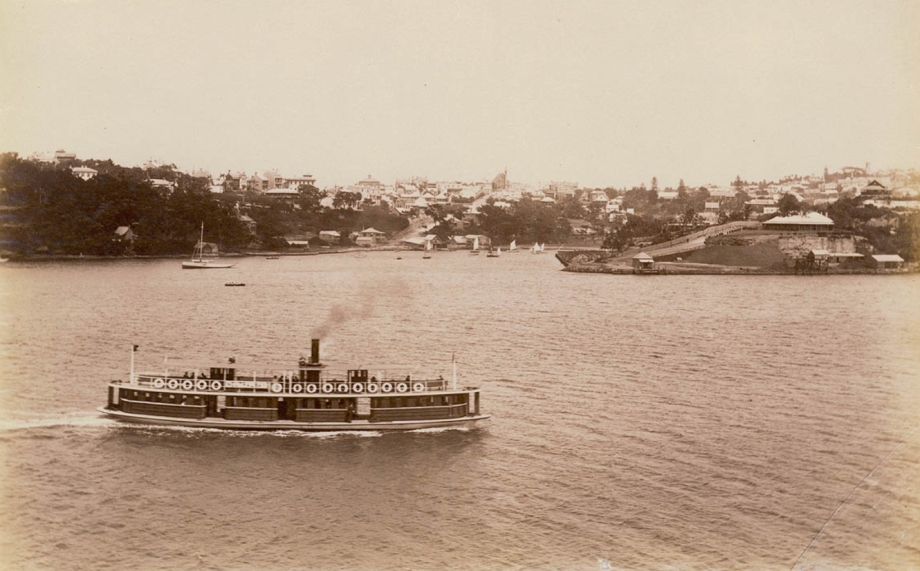
Careening Cove, Sydney Harbour (Neutral Bay) ca. 1900-1910, Image No.: a116087, by Star Photo Co. - Unmounted views of New South Wales, courtesy State Library of NSW
I went to Tech, and the foreman was pretty good; he allowed me to make a few models on the side; pinch advice and whatnot.
Barbara and I then became very good friends with a sail-maker named Joe Pearce, ‘ratsy’ we called him. He befriended us. I told him I’d like to get into some of the other yards that were building big yachts. He organised for me to meet the Holmes brothers, they had a yard in McMahons Point. I didn’t get an apprenticeship there be he introduced me to George Riddell who worked for F J Palmers (RPAYC – 1950) building a yacht called the Eden, which was one of the biggest yachts being built in Australia at that time. He started hot molding boats – so I was very fortunate to learn the vacuum bagging hot molded type of construction way back then, in the early 1950's. It was not until 1970 that they started doing that commercially.
So I was very very very fortunate to work with a boat builder who had the backing of a yachtsman like F J Palmer. He was the man who was integral in building the original clubhouse for the Royal Prince Alfred Yacht Club on Pittwater and the Millions Club in town – I’m not sure he was good for the shareholders but he was great for the sailing community! That was the upbringing in doing my apprenticeship I had. I had a Great time learning the trade as well as designing and sailing my own boats.
F. J. PALMER. Twenty-three years ago Mr. F. J. Palmer, tailor, hatter, and mercer of 12 and 14 Park-street, and 725 and 75 George-street, Haymarket, started business as a hat manufacturer, in Regent-street, In a room about 8ft square. The venture proved successful, and trade so Increased that he had to shift his quarters to the Haymarket, and subsequently open a branch establishment m nu-g.-Btre«. 'iv tae nutinMs of hat manufacture. he quickly added those of tailoring, outfitting, clothing, and mercery, and to-day his name for Uptop goods Is one of the best known, not only throughout the city and suburbs, but In many of the country districts throughout the State. Mr. Palmer claims to be a staunch believer In giving emp^oynient In the manufacture of his goods to the people of the colony. In every Instance where the law governing trade allows him and he at all times tries to keep his stock right upf- date. Starting with the proverbial 'hand-basket.' the business has become one of the best established In Sydney. Mr. Palmer looks after the Park-street shop, while his son has the management at the one at the Haymarket. F. J. PALMER. (1903, December 11). Evening News (Sydney, NSW : 1869 - 1931), p. 7. Retrieved from http://nla.gov.au/nla.news-article113793684
F. J. PALMER OFFER. The offer of F. J. Palmer Holdings Ltd. to the holders of ordinary and preference shares of Cooee Clothing Ltd. has been accepted by holders of more than 90 per cent, of each class. F. J. PALMER OFFER. (1953, September 19). The Sydney Morning Herald (NSW : 1842 - 1954), p. 6. Retrieved from http://nla.gov.au/nla.news-article18385615
If I’d served more time after I’d done my Technical course, done another year and then become an architect, a naval architect they called them then. That didn’t interest me as the work of naval architects on those days was in ships and it was all calculations and slowly drawing boats – I’d done my education and was done – I wanted to get on with building boats and living my life.
Pritchard Bros, have on hand a handsome 25ft cruiser for Mr. H. V. Lawes, a member of the Motor Boat Club. A 3h.p. Hercules engine will be installed in Mr. Lawes' craft. Holmes' yard, as usual, is busy, and he has just turned out two useful types of working tenders 30ft long, for Messrs. Clark Bros., Brisbane, to be used in connection with their pearling fleet. In each is to be installed an 8-h.p.,two-cylinder Standard motor, and they should prove first-class sea-boats. Holmes also has a fine 40ft cruiser for Mr. A. E. Pearce, of Randwick, designed by Mr. Walter Reeks, for outside pleasuring and fishing. In her is to be installed a 16-h.p.Standard engine. Mr. Harry Rickards' cruiser is well forward, and is to carry a Twentieth Century 15-h.n. motor. She has the fashionable American overhanging stem, and is very full aft, which should make her powerful as well as speedy. NEW BOATS. (1906, August 22). Referee (Sydney, NSW : 1886 - 1939), p. 11. Retrieved from http://nla.gov.au/nla.news-article120320475
When and where did you meet Barbara?
I met her through her cousin – her cousin was a blonde and she was a black head and I’d gone for the blonde but then found out she was a much better bird anyway, so I swapped. This was 1954. We got married in 1957.
Barbara: we got married in Botany – I came from Mascot.
What did you do after you got your ticket?
Ken: I worked for some good boat builders – a bloke called Sidney Ferguson
Barbara: we got married and he made out a cheque to me for Ken’s work.
Ken: we then built a very good boat called ‘Hi-Bas’, named after Barb, a 16-footer, and went across to Perth for the Australian titles; that was a beautiful boat, lovely boat; probably the best boat I ever built. It was really way in front of everything; it had all sorts of things in the centreboard that would make the centreboard go one way so you could make the sails go another. We got runner-up in the Australian titles in Perth in that. A guy over there, Bruce Glasken, wanted to buy it and I said no, I wanted to take her home and win the club championships in Middle Harbour, which we did.
He gave me a deposit on a new boat, and that got us home from Perth - otherwise we’d still be sitting in Perth. We then went down to the Spit and hired the Lyon’s boatshed – the boat building part on the western side and we were there for around five and a half years, and I built 129 boats while we were there.
That is phenomenal!
Ken: most of them were 16-footers, smaller boats, some yachts. I had some great guys working for me.
Who stood out among them?
There was Errol Perry, Billy Fisher, Jim Gannon, Ian Perdriau – Arthur Barnes. There was an old fisherman bloke down there – he used to round off the masts and the oars and the sculls we used to make – Harold Sherwood; he was a lovely man; he shagged every woman on Seaforth I think – he wasa a goer- I can remember when he was about 85 and he was still walking up old Seaforth hill there to see if he could find someone walking back and forth across Seaforth bridge there. (laughs) He was a character.
What came next?
Barb had Colin – we had built a skiff called ‘Nu Babe’ and we won the State Title in that on the same day Colin was born.
Colin came along and I was building fishing boats down the Spit for a famous guy called George Baker, a lovely man from Balgowlah and I’d build his boats for him; I was building one for him while Barb was pregnant and he asked me what I was going to call my baby when he came along- I said, if it’s a boy I’m going to call him ‘Pedro’ and George sent Barb a card that said ‘Happy Pedro’ to which Barb said ‘who’s this Pedro?’ – which I thought was pretty good.
Barbara had a friend who was in the next bed when she was having our first baby, Colin; that reminds me of another funny story; I was late getting to the hospital. When I got to Manly Hospital it was all dark, all closed up. I thought, ‘I’ve got to go in and see Barb and see the kid’. I was wandering around outside and saw a door open so I went in. in those days they’d have two ladies in a room and the babies too for feeding. So I snuck in and said hallo to Barbara and she said the boy would be coming in soon for his feeding – so I hid under the bed. They brought one baby in for the other lady, and it thought – yeah that’s ok, but where’s my kid?! - still under the bed – and I then got up and said hallo. By that time they’d closed the place up completely because there was a prowler lurking around Manly then. They’d locked all the doors and I couldn’t get out – the only way out was to jump out the window – which I did, thinking ‘I’ll be done as the prowler!’.
At any rate, Barbara’s friend at the hospital had a house at Church Point and we were thinking about trying to buy a bit of land. We’d brought a house at Seaforth, an 89 foot waterfront, built a boatshed there, built a lot of boats there too somehow, and we were then building boats there as well as at The Spit.
So Barb went up to see her friend.
Barbara: she was living at Church Point at that stage. On the way home I called in to Church Point to the real estate agent there, a guy called John Hackett – Jack. I went in and asked if there were any boatsheds around here for sale. He said, not really – but there could be one. As it turned out the people who were running the boatshed, the daughter and her husband, had split up and Jack asked them if they’d sell it and they said yes, so that’s how we ended up in Elvina Bay. We moved there in 1962.
What was Elvina like then?
Barbara: very quiet – not busy
Ken: There were five cars at Church Point, and the five cars were the residents of Scotland Island and Lovett Bay and Elvina Bay; and they were the only ones who were full time residents there.
Elvina Bay Boatshed was started by Bluey Ludgater back in 1945-46. It was a commercial boatshed and we paid three times the amount of a single block of land up here for it, so it wasn’t cheap but it was commercial.
We were fortunate that they put the electricity on about a year after we got there – I would have been too difficult for the kids not to have it on. Colin went to school on the ferry. Joanne and Adam were born while we were there.
As for what it was like – it was fantastic – you couldn’t bring a motor boat into Elvina Bay after four o’clock – you had to row in. the kids went to school by ferry, which they still do down there.
You helped Mr. E J Shaw with the Hurrica?
He had Hurrica on the moorings there when we bought the shed, and had it there for some years. Eddie was a beaut bloke and we had, and still have a pretty big slipway there. He said ‘if you buy the block of land next door I’ll help you build a slipway so we can slip Hurrica and bigger boats like her.’ The bloke wouldn’t sell the block and years went by and we eventually got half a block. Eddie brought his bulldozer in from up the top- down the fire trail. We had a lovely house ready to be built there.
We went overseas for a while to build some boats and it was when we there that we got a call that Eddie couldn’t get his bulldozer out – but he did eventually. Nothing could stop Eddie.
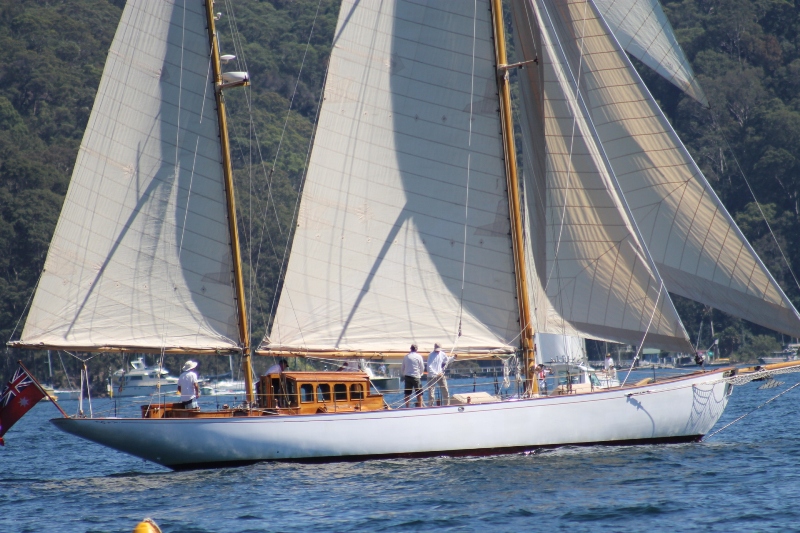
The Hurrica
What boats were you building at Elvina Bay?
At Elvina I built a great variety of boats; Folk boats, Stellas, surfboats, a heap of 12-footers, 16-footers and 18-footers, V.J.’s, V.s', keel-boats, 5.5’s, a 25 foot hire boat, then I started building what they call the Delta now; a little launch; that was my first fibreglass boat; we never made any money out of that but now they’re everywhere.
What were your favourites to build?
It was good building a boat I designed, therefore; the 16’s, the 18’s, the 12-footers – that was really good. I really enjoyed building the 5.5 racing boats because they were an Olympic class. I think I’ve enjoyed building every boat I’ve ever built really – but the ones designed, unless they were designed by a really good boat builder like Robert Payne or the Chance brothers, and we built a lot of boats for Robert Chalmers - but I really enjoyed building the boast I designed myself because you could put a bit more into it.
I was very fortunate to learn how to build fast boats, with good construction, and to teach myself more about this along the way. Not only of the wooden type and molded type but when synthetics came around in the form of fibreglass – which I should have gone into but would have become bored with because it’s just production.
I enjoyed building Hitchhiker, the world two ton champion – I enjoyed building that out of kevlah – and a few 18footers for Rob Brown out of carbon fibre.
So I do enjoy all forms of boat building – I enjoyed building aluminium boats in America; they were the go for ocean racing boats because they were stronger than fibreglass and lighter than wood. I enjoyed building boats with Bob Derecktor over there – we were building boats for Ted Turner and boats that won world championships in the maxi series—Boomerang and boast like that as well as building a 100 foot launch or a 19 foot launch, or motor yachts as they call them in America, for very prominent people in the new York Yacht Club; I enjoyed working on a variety of projects there with very nice owners, extremely nice people.
Bob Derecktor – nobody talks much about him?
No- he was a chap that never advertised but at one stage in America he had 400 in the Newport shipyard, 73 in the Mamaroneck, Long Island shipyard and about 100 down at Fort Lauderdale in Florida – he employed a lot of people, built a lot of boats.
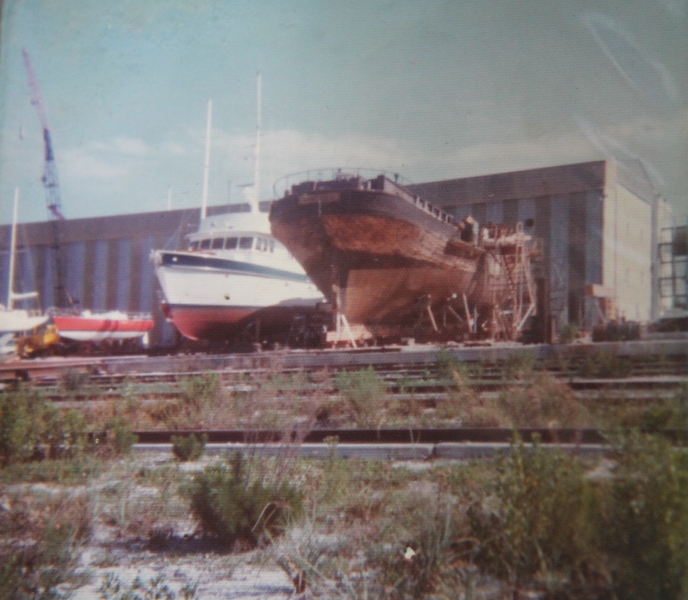
What do you think made him so successful?
Oh, ambition to be another Herreshoff – to rewrite the books in honour of boatbuilding; prominent designers would have a boat built by Bob Derecktor and he’d throw away the construction plans and get his own construction plans in, and his boats never broke up because of that. That was good and bad – I remember Britton Chance coming into me one time over there and saying ‘Ken, where’s the construction plan of this boat I designed?’ this was a boat called Ondine for Huey Long – I said ‘I haven’t seen it.’ …(laughs) ‘That bloody Derecktor!’ he said.
You were over there to race though, weren’t you?
Yes. I was assistant to a him in sailing and in boat building. His boats were successful in ocean racing. He’d won an America’s Cup in Columbia – there were a lot of good sailors that had sailed with him, including Ronnie Swanson – Bob was just a bit of a character in some ways- probably his own worst enemy because people would have him build them a boat but they couldn’t talk to him during working hours; he had a set method to make it happen- he was a very disciplined person when building the boats and you either liked him or you didn’t – we got on with him very well. He was a good person.
Barbara: We loved him, he was a lovely person.
What did the kids think about being in America?
They learnt how to say things like ‘boardwalk’.
Barbara: they were fine. Colin went to school there, Joanne too. Joanne would have been happy to stay there; Joanne is still friends and speaks to them regularly on the Facebook thing.
Ken: beautiful family – lovely home on Long Island Sound. The place we were living in sold 15 years ago for 20 million – so you can imagine – it was a beautiful place to live. We had it made over there – had our Green Cards; a beautiful place to live, great place to work, a great place to go sailing in.
Why did you come home?
Ken: Alan Payne asked me that before he passed away, said 'you were a mug to come home', but ..we were a bit worried about the kids getting older over there.
Barbara: There were a few things over there in relation to kids that we didn’t like.
Ken: It was a beautiful adult life over there – in the boatyard it was a very adult life, the customers we had, I suppose we’d call them the elite, but they didn’t carry themselves that way. They were just very nice people. They were just like mates in Australia are to us. It was good.
How did you get home? On Mother Goose?
Barbara: Yes.
Which route did you take?
When we put Mother Goose together we put a tabernacle in her thinking we might do an Olympic campaign in Europe. We were going to come down through the Suez Canal but they closed the Suez Canal; so we didn’t do that.
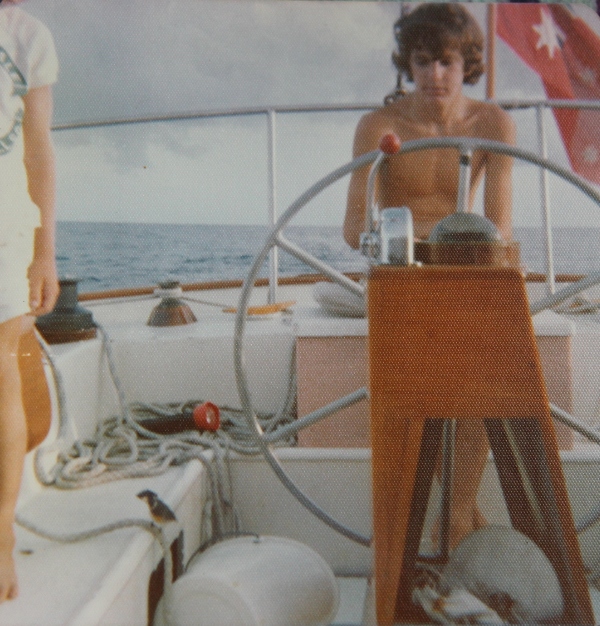
Colin - steering Mother Goose home.
We sailed down from New York in the middle of Winter and worked in the Fort Lauderdale yard at Florida for seven months. They wanted me to run that one, to take over – we wanted to get out of New York, it was getting a bit cold and it’s hard for kids. Australian kids want to get outside, out where it’s big and wide and they can run around. It’s great living on a boat in New York in Winter – you see all the seagulls walking along on thick ice – they stay out of the water, don’t swim at all over there.
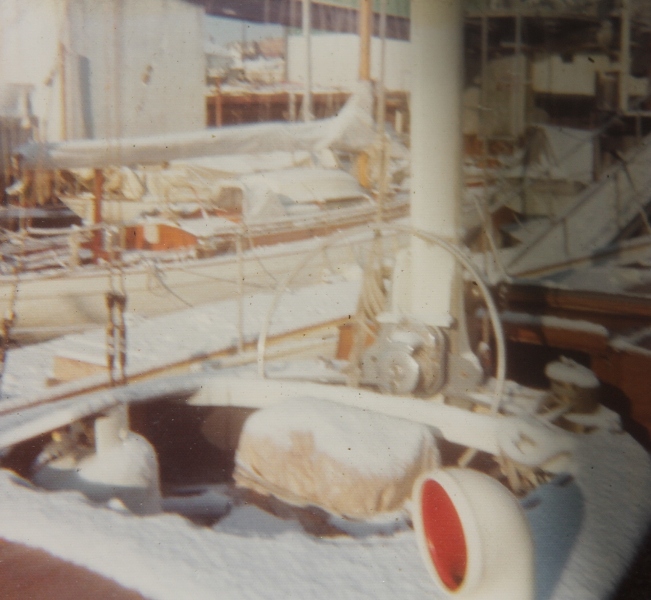
Mother Goose with
snow on her decks when leaving New York.
No shags diving in the water over there. New York is a wonderful place, it really is, but we had a beautiful time sailing down form there to Florida through the inland waterway.
How long did it take to get Mother Goose ready to sail home?
We bought her when Southern Cross was over there for the Cup (America’s Cup) in 1974 and we left in 1975 after that. we did about four or five months and then did more work on her down in Florida too. We were fortunate to be able to do that.
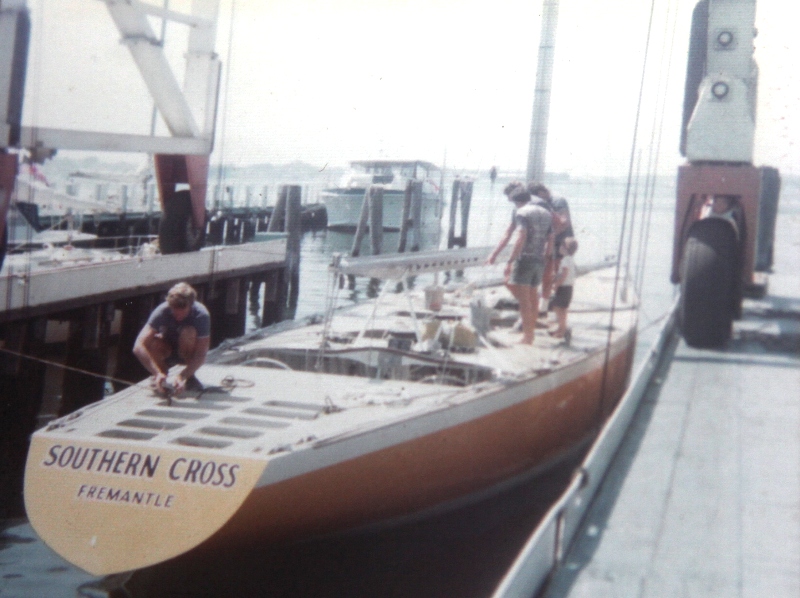
Barbara: we were actually living on board here – in the boatyard, while doing this:
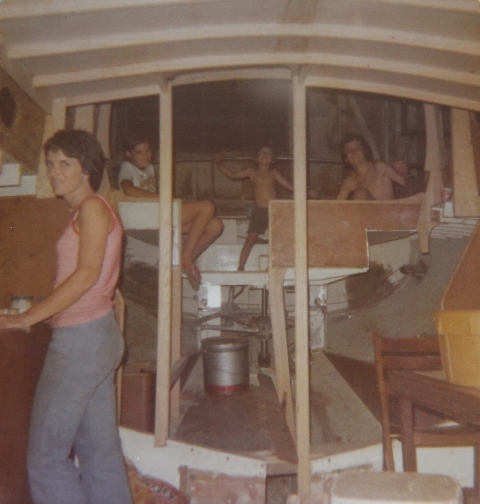
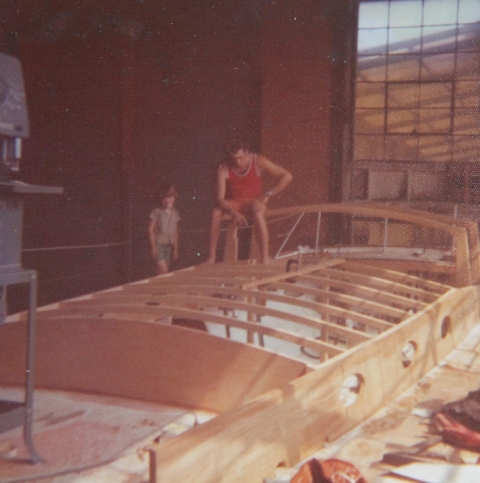
Ken: when we left Florida we went via the Bahamian Islands and leant how to navigate there. We then went through to Jamica, then Panama … Tahiti, Rarotonga and then home. We left Florida on the 13th of August and got here on the 22nd of December. We were 55 sea days from Panama to Sydney.
What did you do when you got back?
Well, we said two years for tidying up and we’ll keep going for the rest of the trip and go around the world…and we’re still here.
We took over the boat yard again from John Morris – whom we’d leased it to. We built the boatshed up again, got it all going again..
And then the America’s Cup came along again?
Yes – we were only back a little while. We got back late in ’75 and I got into half tonners and ocean racing. Then John Bertram asked me whether Colin could sail in the America’s Cup. Colin had won back to back Australian Titles in the Lasers at that time and he'd won other championships. I said ‘yeah, I think he’d be a good hand for you.’ He was the youngest of the crew at that stage. They then asked if I’d go over and run the boat for them – so we went back to America.
I was reasonably confident that we could do well over there because John was a good sailor, I’d sailed with John in Admiral Cup trials in Bond’s boat and had raced against him in the Solings; I knew he was capable and had the discipline that he would need. He had also lived in America so he knew how to beat the Americans; I’d lived in America and knew what was necessary; we knew what we had to do. We weren’t going over there to party, we were going over there to win or not.
The crew he put together worked well together and they all got on well together. We went over there and ran our own campaign, and that’s why we won – we did it the way we saw it – we kept together as a team, there was only 29 of us – there were a lot of people they say they were in the team but I’ve got photos that show there were only 29 of us. We had a New Zealand sailmaker who was bloody good, we knew about American sail cloth – every department was pretty good and came together well. And as Colin said “we probably raced against the slowest 12 metre around – so we had to win it.”
Just on Colin, Joanne and Adam – what is it like to have children who share the same passion and have done so well?
Their passion is fantastic – whatever they’re doing their passion for it is so high, they really want to do it. Barbara rang Colin yesterday to see how he’d enjoyed his weekend and he’d done a five and a half hour bike ride after camping out and on the Sunday got up and did a mountain bike ride – these are 100 kilometre rides. That Sunday of the Classic Yacht regatta he’d done a ride before he came sailing!
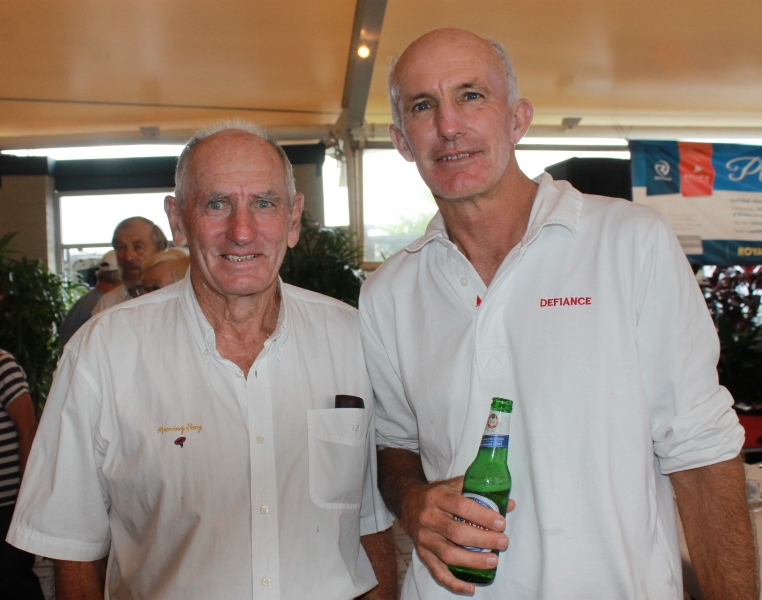
Ken and Colin Beashel - Pittwater Festival's Classic Yacht Regatta
What about your grandchildren?
Barbara: Colin’s boy Aaron is more into the surfing – Jarrod, Joanne’s boy, he’s doing sailing but trains seems to be his passion, with Adam’s two; one is 8 and the other has just turned 6; they have their own Optis.
Ken: they’ve both won races.
Barbara: we’ll have to wait and see.
Ken: there’s a lot of opposition from other sports – so we’ll see how they go.
You mentioned earlier that you’re designing a 40 footer?
Yes, this is for a guy who has land on the Hawkesbury River; he wants a yacht he can sail around the Hawkesbury and has come up with an idea that goes back to the told Chesapeake smacks that were sailed down there. So I’m redesigning one of those with that type of shallow draft; a schooner that will go under the Hawkesbury River bridge so he can sail down to Pittwater and to Sydney. That’s a bit interesting for me.
So you never really retire once you’re sailing man and a boat builder?
I’ve retired from employing labour. I’m happy to work – and still work six hours a day some days.
What is your favourite place in Pittwater and why?
I think all of Pittwater is good. I think the people on the eastern side have got the advantage of looking across a nice body of water to the greenness of the National Park. But to live in that area, where it is National Park, where you have your own waterfront and you’re your own boss – you do have to be able to go out in all weathers, so it teaches you to be unique and it teaches you to be wise as a sailor – but my favourite spot, and time, would be when we first went to Elvina Bay. We could have bought bigger boatsheds on the eastern side but at Elvina we felt as though we were bringing our children up in an area where they could live for that type of lifestyle and all that it brings.
What is your motto for life or a favourite phrase you try to live by?
Sail fast and have fun!
Mother Goose
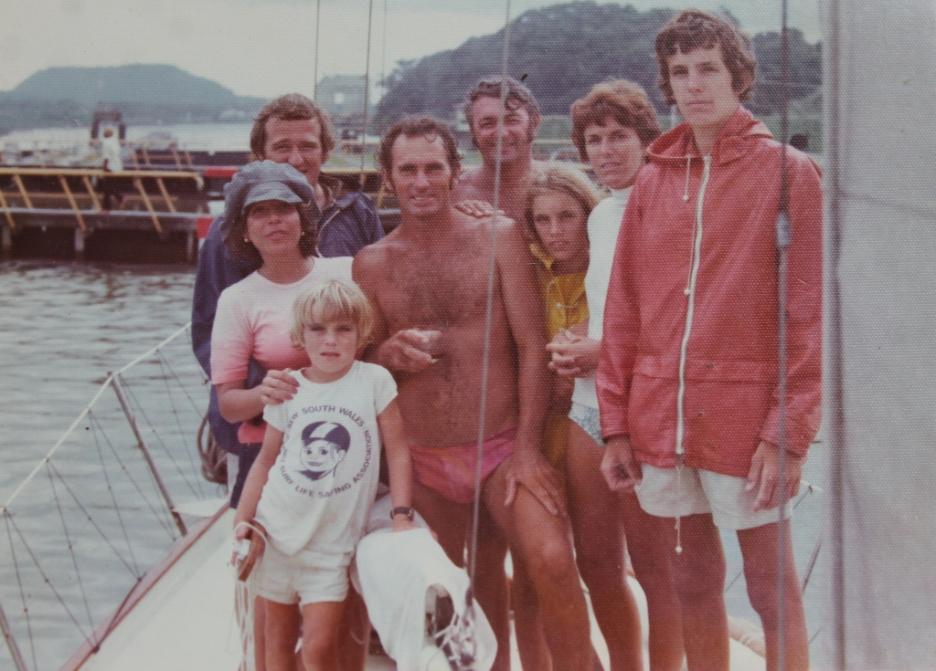
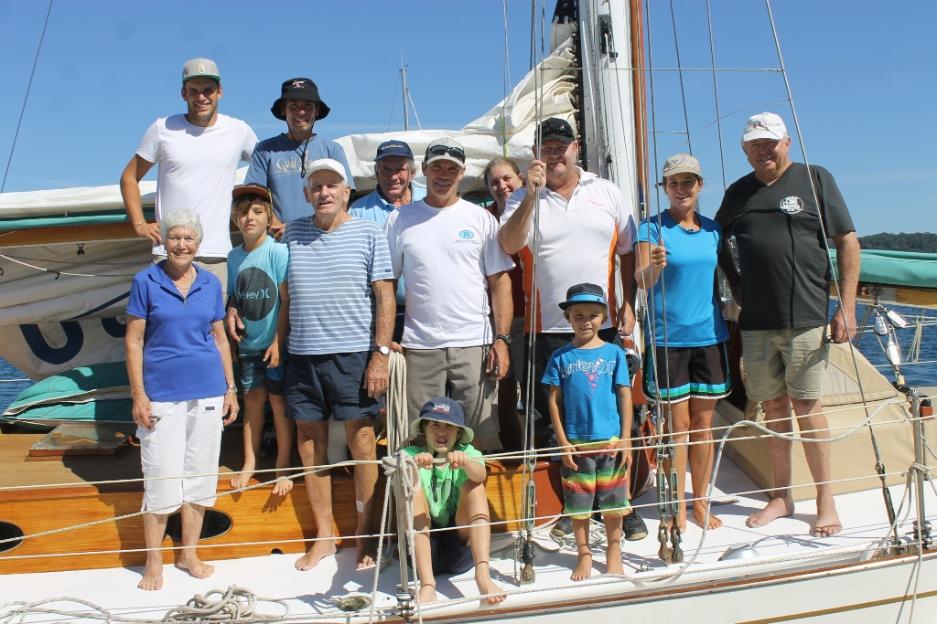
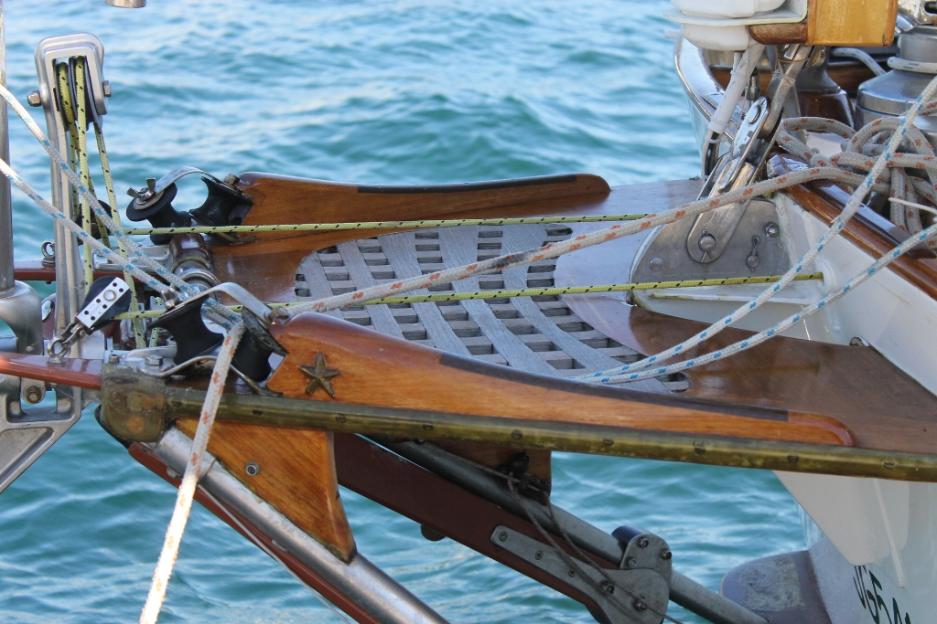
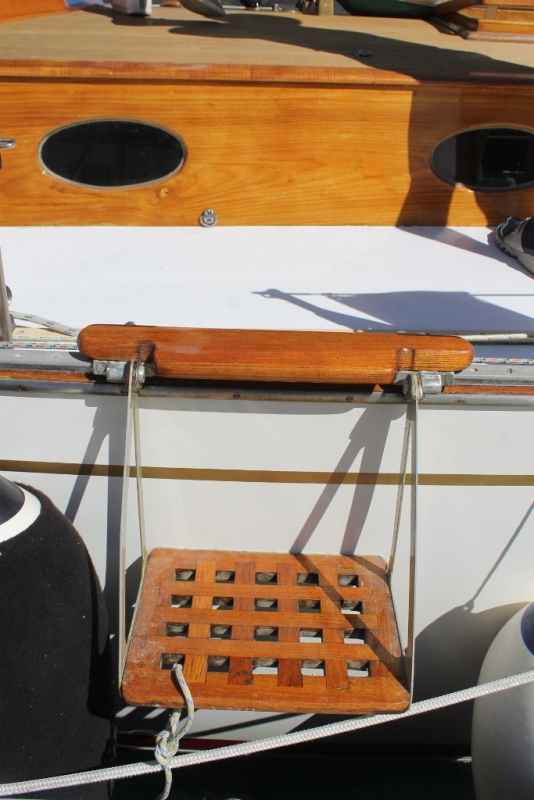
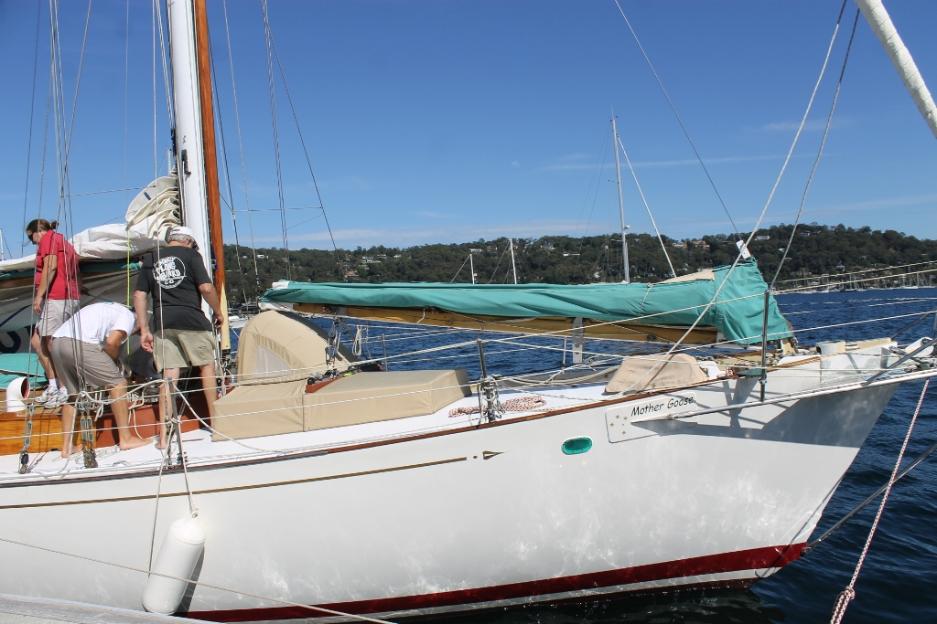
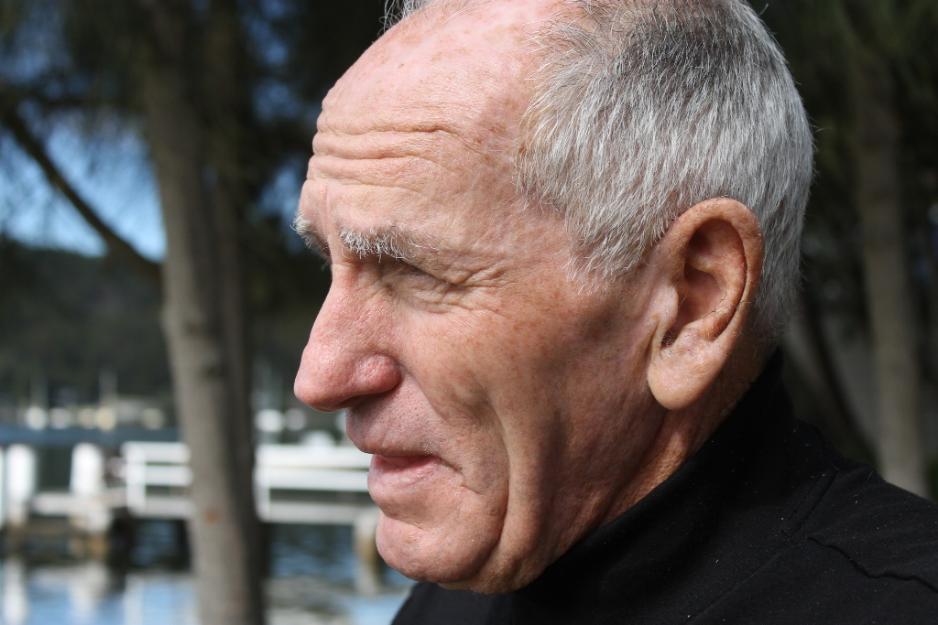
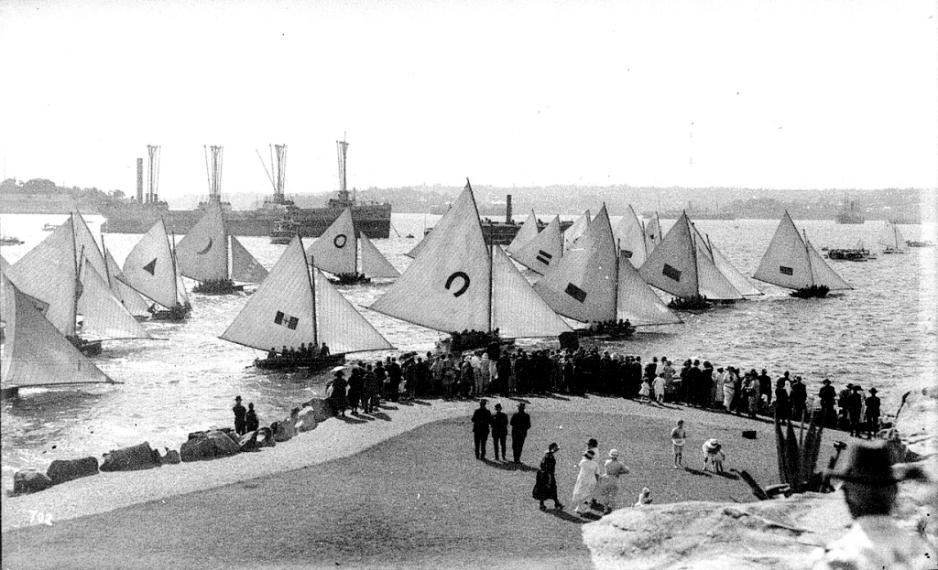
Spectators at a race start in Sydney Harbour, 1920-1925, Object no. 00010579, part of the Australian National Maritime Museum’s William J Hall collection.
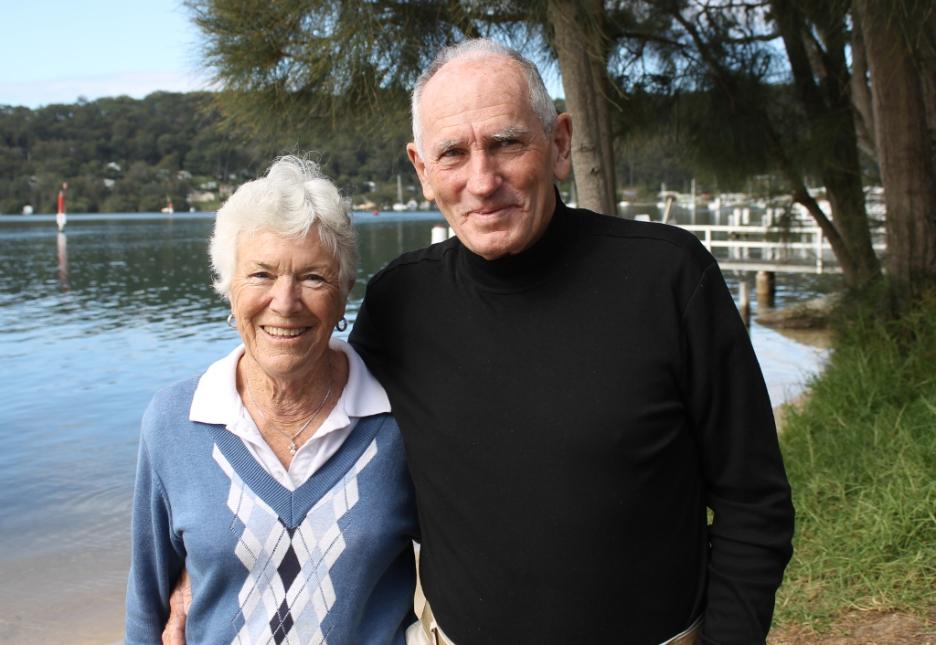
Ken and Barbara Beashel, 2014.